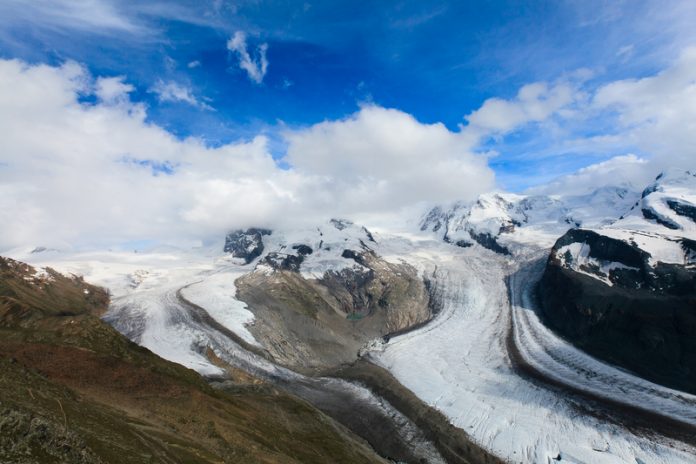The firn and ice of glaciers can be at temperatures far below freezing point, writes Professor Martin Hoelzle of the University of Fribourg
Glacial ice acts as a natural climate and environmental archive and is able to preserve important information about the past atmosphere. Measurements of firn and ice temperatures, however, show substantial warming since the 1990s, even for high-altitude and latitude locations. The expected continued climate change raises concerns that this natural archive will become erased.
The firn and ice of high alpine glaciers in different mountain regions or from ice caps and ice sheets at high latitudes is mostly cold. The term “cold” has a very specific meaning among glaciologists: Cold means that the glacier has a temperature below freezing over the entire year, as opposed to “temperate” ice which refers to ice that is at the pressure melting point (about 0°C). In the Alps, for example, most glaciers are temperate and there are no glaciers which are entirely cold. Often, one finds cold and temperate ice coexisting in accumulation or ablation areas of the same glacier. Such glaciers are then called poly-thermal.
The largest poly-thermal glacier in the European Alps is the Grenzgletscher in the Monte Rosa area. Large parts of the Greenland ice sheet, virtually the entire Antarctic ice sheet, and many glaciers and smaller ice caps of high mountain Asia consist of cold or poly-thermal ice.
Information stored in snow and ice cannot be washed out
Cold accumulation areas are very important for ice core research focusing on the reconstruction of environmental and climate history. They allow analysis of climate evolution in areas where there are no direct instrumental observations. Cold thermal conditions ensure that practically no meltwater can arise and percolate through the porous firn layers, so that the information stored in the snow/ice crystals, and in the trace gases within air bubbles cannot be displaced or washed out.
The first ice temperature profiles were measured in the 1950s at Camp Century in north-west Greenland and they revealed temperatures of -24°C at the surface and -13°C at 1,400m depth at the interface between ice and bedrock. In recent years, firn and ice temperatures have been measured in the Alps within several tens of boreholes.
According to these studies, cold firn can occur between 3800-4800m above sea level. The measured average firn temperature in the Mont Blanc summit area reaches down to about -15°C and down to around -12°C on the Monte Rosa. What is surprising is the large spatial variability of temperatures observed on the glaciers: Actual ‘cold spots’ on shady slopes or flat saddles with little snow accumulation alternate with almost temperate parts in exposed southern slopes with high amounts of solar radiation.
Measured englacial temperature profiles also reflect the surface temperature history and can thus be interpreted as a climate archive. However, this applies only if the conditions on the surface (snow accumulation, melt energy input, etc.) have not changed too dramatically over the reconstruction period. In Greenland, for instance, a reconstruction of the surface temperature over a period of several thousands of years back in time was possible. The Last Ice Age (around 110,000 to 12,000 BP) showed a temperature decrease of around -23°C, the Climatic Optimum (around 9,000 to 5,000 BP) showed an increase of about +2.5°C and the Little Ice Age (around 15th to 19th century) about -1°C in comparison of today.
Microclimatic influences on firn and ice formation
However, as the increase in air temperatures today is very fast, we have to better understand the microclimatic influences on the formation of cold firn and ice. Therefore, the energy fluxes between the atmosphere and cold snow and firn were investigated in detail. Measurements have shown that short but sometimes intense snowmelt events are a major factor in quickly increasing englacial temperatures. The latent heat released by refreezing of percolating meltwater causes a rapid increase in temperature within the firn/ice body and creates ice layers several centimetres to metres thick. This effect is of great importance, because it could warm large firn areas in cold environments like Greenland and the high mountains of Asia.
However, recent studies from Greenland show that the production of ice layers can also have impacts counteracting the direct warming of deeper layers in the firn. The meltwater created during the recent series of warm years has refrozen in near-surface ice lenses so thick that they now act as an aquiclude (an impermeable layer of water). These ice layers of several metres in thickness prevent the percolation of further meltwater and force meltwater to run off along the surface. Therefore, the deeper firn layers cannot be warmed by percolating meltwater through the effect of latent heat release by refreezing any more. The increased meltwater production has serious implications, among which is the increased runoff of glaciers, ice caps and ice sheets leading to an enhanced sea level rise and the erasure of the valuable historical and environmental information stored in cold firn and ice. Ice cores therefore need to be drilled soon in sensitive warming areas to avoid losing the climate records stored in these unique archives.
Furthermore, stability of steep hanging glaciers frozen to bedrock can be weakened due to increased meltwater running along the bedrock, resulting in large ice avalanches endangering the valleys below. For these reasons, it would be considered a strong asset to install a world-wide firn and ice temperature monitoring system embedded in the already existing international monitoring strategies of glaciers, ice caps and ice sheets of the Global Terrestrial Network on Glaciers (GTN-G) within the Global Climate Observing System (GCOS).
Martin Hoelzle
Full Professor, Physical Geography
Department of Geosciences
University of Fribourg, Switzerland
Tel: +41 26 300 90 22
http://www.unifr.ch/geoscience/geographie/en/staff/physical-geographygroup/prof.-m.-hoelzle
Please note: this is a commercial profile











